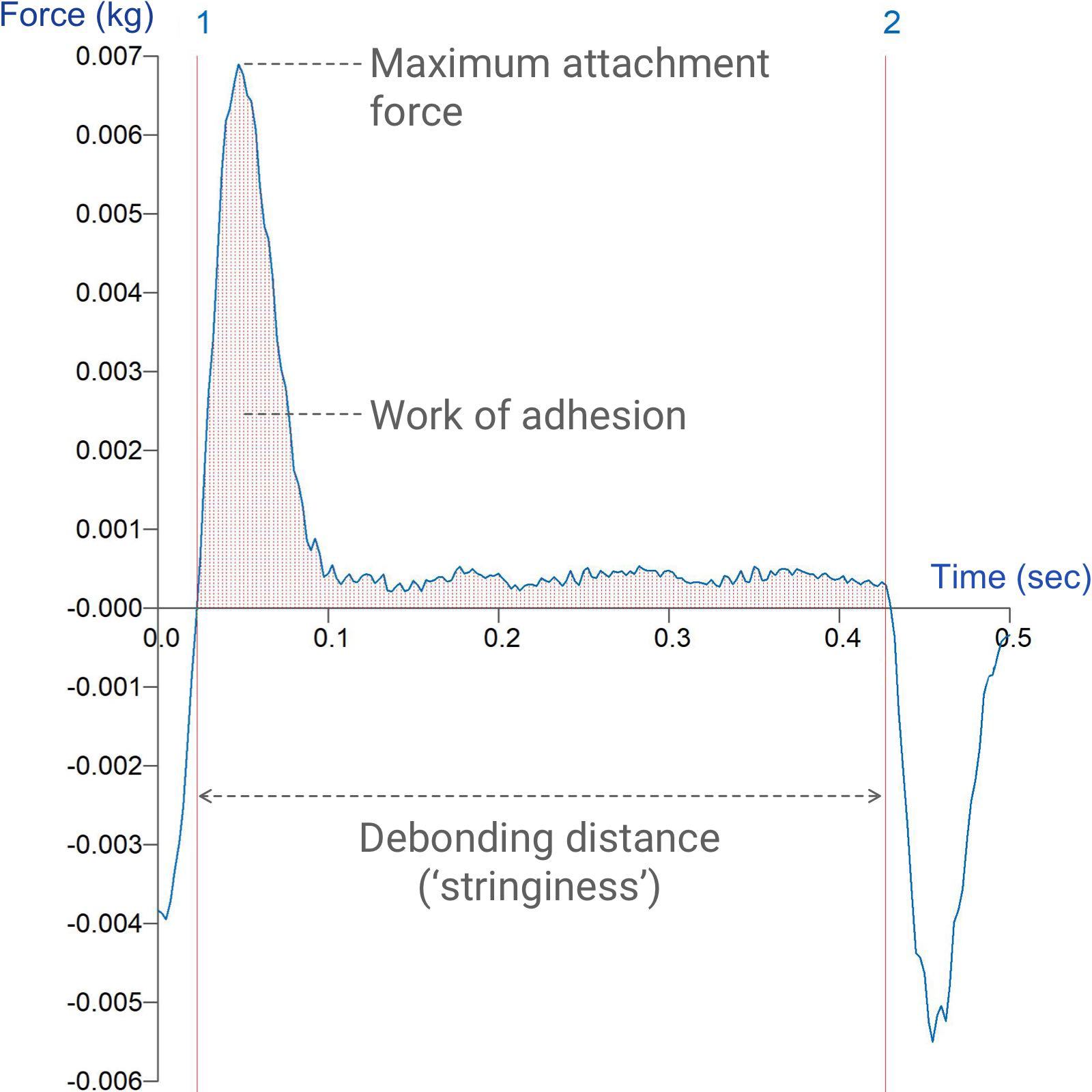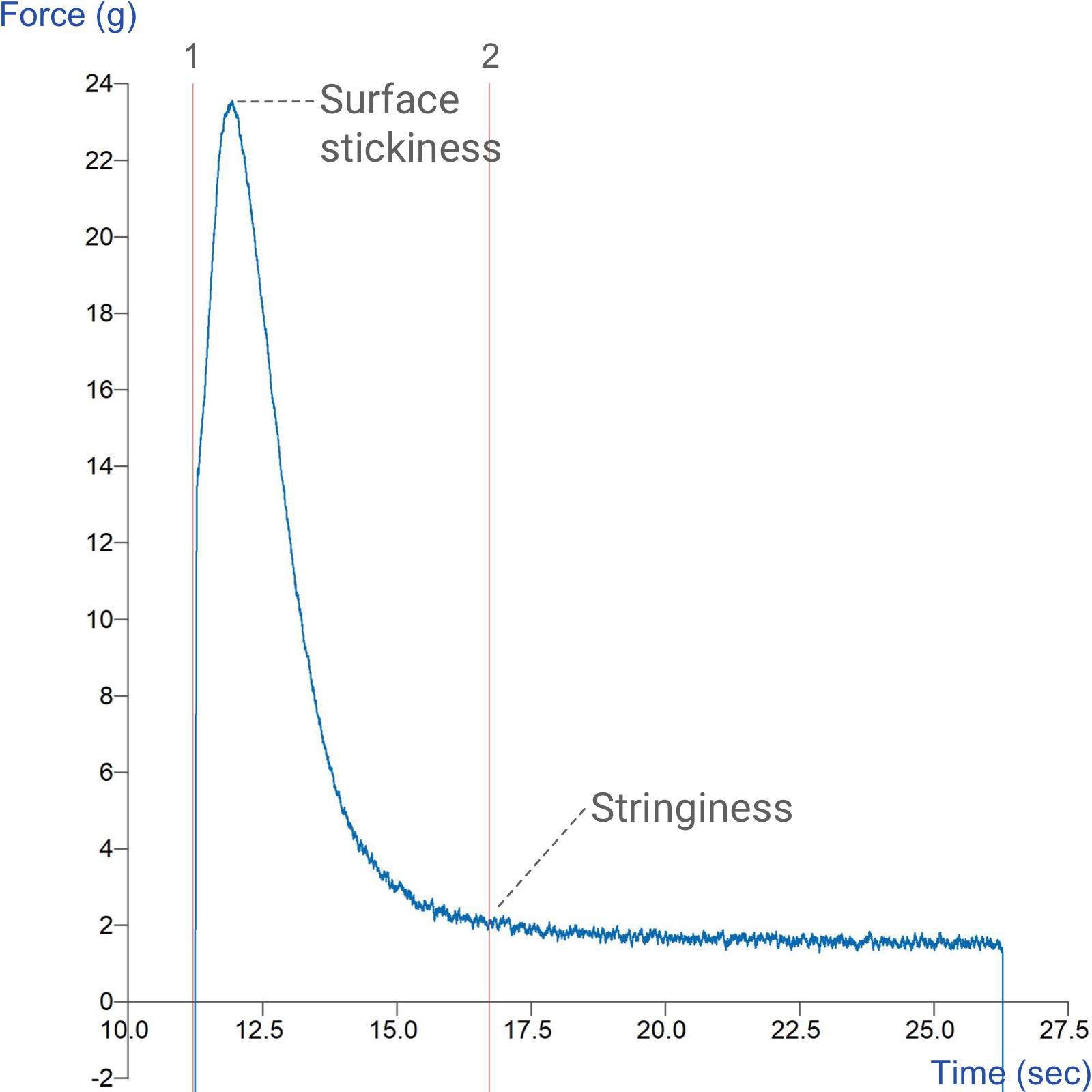How to measure stringiness / shortness / tailing

Stringiness/shortness: definition and importance
Stringiness, shortness, and tailing are terms commonly used to describe the textural and rheological properties of semi-solid or viscous materials, particularly in the food industry (e.g. sauces, syrups, doughs), cosmetics (e.g. creams, lotions), and adhesive products. These properties reflect how a material behaves when it is stretched, pulled, or separated, offering insights into its flow, cohesiveness, and elasticity.
Stringiness refers to the degree to which a product forms long, thread-like strands when stretched or pulled. It is commonly seen in products with high viscosity and elasticity like mozzarella cheese, sauces, thick syrups, and adhesives. In contrast, shortness describes materials that breaks cleanly (and with a small detachment distance) when pulled apart and does not form threads or filaments, which is often desirable in products like pastry crusts or paints that require a clean break. Fatty, crumbly, or low-elasticity materials often exhibit shortness, meaning they resist stretching and break easily.
The texture, flow behaviour, and viscoelasticity of these materials are key factors in determining stringiness or shortness, and tailing refers to the residue or filament left behind after the material is stretched or dispensed.
Stringiness may be a desirable property, as is the case for mozzarella cheese or caramel decorations, but be considered undesirable for the application of paint where a 'short' texture is required for quick and clean removal of brushes from paint tins.
Further example applications of stringiness, shortness and tailing testing
Stringiness, shortness, and tailing measurements using a Texture Analyser are vital for optimising texture, flow behaviour, and product performance in industries like food, adhesives, and cosmetics. Below are key applications:
- Confectionery stringiness measurement: Assessing the stringiness of materials like caramel by measuring the force needed to stretch them and the length of the resulting strings.
- Cheese stringiness analysis: Melted cheese, such as mozzarella or cheddar, exhibits stringiness when pulled apart. The long, elastic strands are desirable in pizza or grilled cheese. The stringiness of mozzarella or other cheeses can be measured by stretching the sample and quantifying the string length and force required.
- Sauce shortness evaluation: Thick sauces like mayonnaise or ketchup can exhibit tailing when lifted from a spoon, leaving a thin residue behind. Controlling tailing is important to avoid undesirable trailing effects in sauces.
- Pastry shortness testing: Shortbread dough is characterised by its shortness, breaking cleanly without stretching. This property is desirable for producing a crumbly texture in cookies. Measuring the shortness of pastry or biscuit dough by applying tension to determine the point at which it crumbles or breaks is important.
- Confectionery glaze stringiness: Testing the stringiness of confectionery glazes or syrups by measuring how long the glaze stretches when pulled apart.
- Cosmetics properties: Evaluating the tendency of products like mascaras or adhesives to leave residues or filaments when dispensed by measuring the length of the tail left behind. Cosmetic gels, such as hair gels or some facial creams, may exhibit stringiness if they stretch into threads when applied. This can affect the ease of application and the overall user experience. Lotions and creams that break cleanly when applied without leaving behind threads or tails are preferred for smooth application.
- Adhesive tailing measurement: Evaluating adhesives by measuring the extent of tailing when the adhesive surfaces are separated to assess how long the filaments stretch. Certain adhesives, especially those used in packaging or construction, can exhibit stringiness/tailing, which can make them difficult to handle and apply neatly. Short adhesives that break cleanly when pulled apart are easier to apply and control, making them more desirable in certain packaging and sealing applications.
- Toothpaste stringiness and tailing: Testing the stringiness and tailing of toothpaste by measuring how far the product stretches when squeezed.
In these examples, a Texture Analyser is used to apply controlled forces/distances to materials, quantifying their stringiness, shortness, or tailing properties. These measurements are essential for product development, quality control, and ensuring optimal consumer experience across various industries.
Typical probe/attachment used for measurement
Two main techniques are used to measure stringiness/shortness:
Adhesive test
In a typical stringiness/shortness/tailing measurement test, a probe is pressed onto/into the sample and then withdrawn. The distance required to detach the probe from the sample is recorded but requires the probe to withdraw to a distance that is greater to ensure this point occurs.
Tensile test (Basic Return to Start test)
In this test, the material is stretched beyond its break point.
Tensile test (Basic Return to Start test)
Alternatively, a tensile test can measure this property – again this requires the sample to be stretched to a distance that is greater than sample stretch to ensure this point occurs.
How to interpret the Texture Analyser graph
 Typical curve indicating key analysis points of an adhesive test
Typical curve indicating key analysis points of an adhesive test
Adhesive test
This test allows the choice of an applied force of the probe to the material. This provides a high degree of repeatability of the contact between the probe and material surface and allows a hold time to be chosen to achieve a good bond between the two surfaces before the probe/attachment is withdrawn. This test present adhesive properties in the positive region of the curve. From the graph you can observe/obtain the following:
- Consistency
- Firmness
- Cohesiveness
- Tailing, Stringiness
- Shortness
- Viscoelasticity
 Typical curve indicating key analysis points of stringiness measurement from a tensile test
Typical curve indicating key analysis points of stringiness measurement from a tensile test
Tensile test (Basic Return to Start test)
Full explanation of these curves and their analysis can be found within Exponent Connect software. Below is an example of how we can help you understand curve analysis for an example property.
Key factors affecting stringiness, shortness and tailing measurement
- Material composition: Materials high in proteins, starches, or polysaccharides often exhibit stringiness due to their molecular structure, which allows for elongation and stretching. Examples include melted cheese or sugar syrups. Fats and oils, on the other hand, tend to create short materials, as they lack the molecular elasticity required for stretching.
- Viscosity: High-viscosity materials tend to exhibit stringiness because they flow slowly and resist separation. For example, thick honey or caramel will form long strings when pulled apart. Low-viscosity materials typically break cleanly, exhibiting more shortness.
- Elasticity: Materials with high elasticity are more likely to be stringy, as they can stretch significantly before breaking. Elastic materials, such as gluten-containing doughs or gels, tend to form strands when pulled. Low-elasticity materials, like shortbread dough or pastes, break quickly and cleanly, leading to shortness.
- Moisture content: Materials with higher moisture content may exhibit stringiness, as the water provides flexibility and helps the material stretch without breaking. Drier materials are more likely to be short, as the lack of moisture makes them more brittle and prone to breaking.
- Temperature: Higher temperatures can increase stringiness by reducing viscosity and allowing the material to flow and stretch more easily. For example, melted cheese is stringier when hot. Lower temperatures tend to increase shortness, as cooler materials are stiffer and more likely to break cleanly.
- Test speed: The rate at which the sample is stretched or pulled can influence the measured stringiness, as some materials may exhibit different extensional behaviours at varying speeds.
- Probe geometry: The shape and size of the probe used in testing can impact how the force is applied and distributed, affecting the measured stringiness and tailing behaviour.
- Initial compression force/distance: The force/distance applied to the sample before stretching can affect the initial contact area and subsequent stringiness measurement.
- Probe withdrawal distance: The distance over which the probe is withdrawn affects the extent to which the sample can form strings or tails.
- Environmental conditions: Factors like humidity can influence the sample's properties and consequently its stringiness and tailing behaviour.
Optimising stringiness/shortness/tailing measurement and analysis: The Stable Micro Systems advantage
The Stable Micro Systems Texture Analyser excels in optimising measurements of stringiness/shortness/tailing through its comprehensive approach and specialised features. It accurately quantifies multiple properties including consistency, firmness, cohesiveness, index of viscosity, tailing, and viscoelasticity, providing a holistic view of a product's stringiness characteristics.
Equipped with dedicated tools like Cylinder Probes, and the Back Extrusion Rig and Cheese Extensibility Rig, it precisely measures stringiness across a wide range of products from mozzarella cheese to confectionery glazes.
The Texture Analyser and its Exponent Connect software provide a unique adhesive test that allows PID controlled sample preparation and captures detailed force-time-distance profiles This enables in-depth analysis of stringiness behaviour and accurately measures the degree to which a product hangs on the probe when withdrawn.
Backed by Stable Micro Systems' expertise in graphical interpretation and method development, this makes the Texture Analyser the ideal choice for researchers and manufacturers seeking to refine product formulations and maintain quality standards in stringiness, shortness, and tailing testing across various industries.
Tailored grips and attachments for precise adhesion and tensile testing.
Comprehensive analysis of graph features obtaining multiple parameters.
Ability to additionally capture synchronised video for better understanding of product behaviour.
Micron-level deformation accuracy and unique adhesion test sequence.
If you need help with your tensile force measurement, we offer unrivalled support.
We can walk you through the steps to successful testing and analysis of tensile forces/distances.








